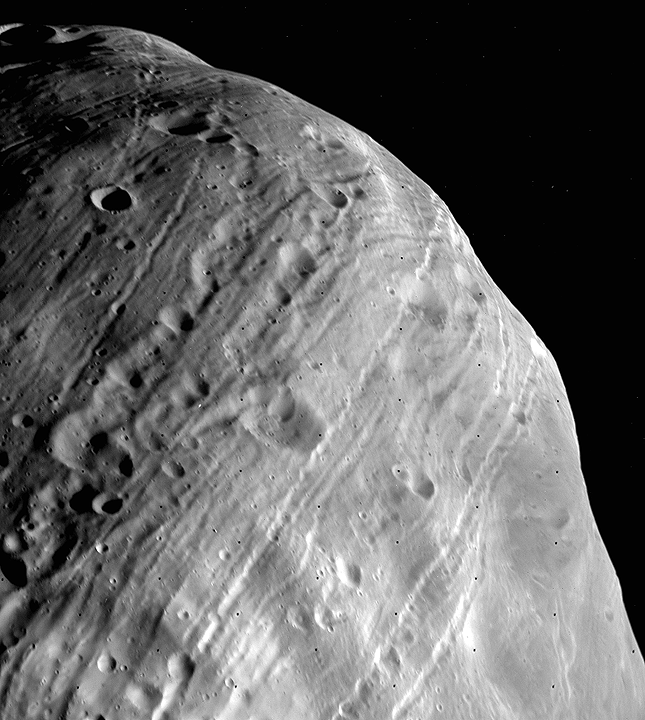Phobos. Image: NASA
Mars's largest moon, Phobos, is gradually being pulled toward its home planet, caught in the tractor beam that is Mars's gravity. Phobos orbits Mars faster than the planet rotates, and as such, the moon is caught in a cosmic chain reaction that will ultimately end in its demise. Sorry Phobos, but your days are numbered.Phobos is unique in a number of ways. Aside from its fast orbital speed, the small moon is among the darkest in the Solar System, and similar in composition to the black, carbon-rich asteroids in the outer asteroid belt. Orbiting just 3,700 miles (6,000 kilometers) above the Martian surface, Phobos orbits closer to its planet than any other moon in the Solar System. Due to its close proximity, Mars's gravity is slowly pulling the moon in at a rate of approximately 2 meters (6.6 feet) every hundred years. At this rate, scientists predict the moon will be ripped apart by tidal forces in the next 30-50 million years.Believed to be a captured asteroid, Phobos is quite literally one groovy moon. The surface is scarred by long, shallow grooves that appear to originate from one massive crater: Stickney crater, which is nearly half as large as Phobos itself, and is believed to have formed from an impact so massive it nearly shattered the moon.However, new data combined with computer modelling reveals the grooves to be more like lunar stretch marks than impact-induced fractures. Caused by the tidal tug of Mars, the grooves are the first visible sign of Phobos' impending doom."We think that Phobos has already started to fail, and the first sign of this failure is the production of these grooves," Terry Hurford of NASA's Goddard Space Flight Center in Greenbelt, Maryland said in a press briefing. At the 47th annual Division of Planetary Sciences meeting in National Harbor, Maryland this week, NASA announced these findings and predicts the moon will be ripped apart by tidal forces before it can crash into Mars.When the Viking spacecraft first observed Phobos in the 1970s, scientists predicted the gravitational pull between Mars and Phobos were causing the moon to fracture. However, at that time the moon was thought to be solid all the way through. As such, the tidal forces exerted by Mars would have been too weak to be causing the grooves.Scientists now believe that Phobos is a cosmic beanbag. Basically, a pile of rubble barely holding together and covered in a layer of powdery regolith approximately 330 feet (100 meters) thick. This is common among asteroids, and helps to back up the theory that Phobos is a captured asteroid and did not form from the same material that Mars did."The funny thing about the result is that it shows Phobos has a kind of mildly cohesive outer fabric," Erik Asphaug, a co-investigator on the study, said in a news release. "This makes sense when you think about powdery materials in microgravity, but it's quite non-intuitive."An interior like Phobos's is easily distorted, forcing the outer layer to adjust which results in the fractures we see on the surface. This means that tidal forces are more than capable of producing enough stress to cause the surface fractures. Data shows that some of the grooves are younger than others which leads scientists to believe that the process is ongoing. These findings, coupled with computer models showing predicted stress fractures line up almost exactly with the grooves we see in images, further confirms the theory that Phobos is slowly being shredded.By understanding how tidal forces affect Phobos, astronomers can gain a sense of what sort of processes are occurring on planets outside of our Solar System, commonly referred to as exoplanets. "We can't yet directly image distant exoplanets to see what's going on, but this work can help us understand those systems, because any kind of planet falling into its host star could get torn apart in the same way," explained Hurford.Although Phobos isn't going to meet its demise for millions of years to come, we may want to add the moon to our list of places to explore. When asked about Phobos' fate and the implications for future Mars missions, Hurford explained, "We can learn a lot about its structure by studying the interior from its surface. Phobos could be an exciting place to go before Mars."
At the 47th annual Division of Planetary Sciences meeting in National Harbor, Maryland this week, NASA announced these findings and predicts the moon will be ripped apart by tidal forces before it can crash into Mars.When the Viking spacecraft first observed Phobos in the 1970s, scientists predicted the gravitational pull between Mars and Phobos were causing the moon to fracture. However, at that time the moon was thought to be solid all the way through. As such, the tidal forces exerted by Mars would have been too weak to be causing the grooves.Scientists now believe that Phobos is a cosmic beanbag. Basically, a pile of rubble barely holding together and covered in a layer of powdery regolith approximately 330 feet (100 meters) thick. This is common among asteroids, and helps to back up the theory that Phobos is a captured asteroid and did not form from the same material that Mars did."The funny thing about the result is that it shows Phobos has a kind of mildly cohesive outer fabric," Erik Asphaug, a co-investigator on the study, said in a news release. "This makes sense when you think about powdery materials in microgravity, but it's quite non-intuitive."An interior like Phobos's is easily distorted, forcing the outer layer to adjust which results in the fractures we see on the surface. This means that tidal forces are more than capable of producing enough stress to cause the surface fractures. Data shows that some of the grooves are younger than others which leads scientists to believe that the process is ongoing. These findings, coupled with computer models showing predicted stress fractures line up almost exactly with the grooves we see in images, further confirms the theory that Phobos is slowly being shredded.By understanding how tidal forces affect Phobos, astronomers can gain a sense of what sort of processes are occurring on planets outside of our Solar System, commonly referred to as exoplanets. "We can't yet directly image distant exoplanets to see what's going on, but this work can help us understand those systems, because any kind of planet falling into its host star could get torn apart in the same way," explained Hurford.Although Phobos isn't going to meet its demise for millions of years to come, we may want to add the moon to our list of places to explore. When asked about Phobos' fate and the implications for future Mars missions, Hurford explained, "We can learn a lot about its structure by studying the interior from its surface. Phobos could be an exciting place to go before Mars."
Advertisement

